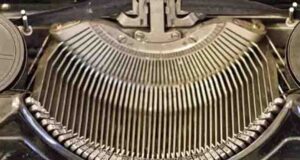THE WHOLE INTERNET COLLABORATED AND COULDN’T FIND WHAT THIS IS. I’M NOT SURE WHAT THIS IS, NINETY PERCENT OF PEOPLE DON’T KNOW TOO…

Journeying Through Time: The Enduring Saga of Typewriters and Their Timeless Allure
Nestled within the tapestry of my memories lies a cherished moment, rooted in my mother’s profession as a diligent journalist. It was a time when words gracefully danced upon the keys of a typewriter, captivating me with its enchanting presence. Seated upon my mother’s lap, I marveled as her fingers waltzed across the typewriter’s keys.
The fragrance of paper mingled harmoniously with the intoxicating aroma of ink, creating an ambiance steeped in creativity and nostalgia.
These typewriters, each a masterpiece in its own right, housed a myriad of models, each bearing its own mechanical heart. As I reminisce, I’m compelled to ask: do you, dear reader, possess a typewriter of your own?
Embarking on a Nostalgic Odyssey with Typewriters
The humble typewriter serves as a poignant emblem of days gone by, a testament to an era of communication distinct from today’s digital marvels and touchscreen sensations.
The tactile symphony of keys meeting paper bore witness to the conveyance of thoughts and narratives. In the subsequent passages, we delve into the historical lineage and enduring legacy of these remarkable writing instruments.
The Ingenious Evolution of Typewriters:
Looking back, we trace the origins of mechanical writing devices to the 18th century. However, it was in the 19th century that functional typewriters began to emerge. The Sholes and Glidden typewriter, famously known as the Remington No. 1, debuted in 1873, marking a significant milestone in the realm of mechanical writing.
This development introduced the iconic “QWERTY” keyboard layout, a configuration ingeniously designed to alleviate the frequent jamming of letter combinations in mechanical typewriters.
The Ripple Effect on Communication and Society:
The introduction of typewriters onto the stage of innovation catalyzed ripples that reverberated far and wide, leaving an indelible mark on communication and society. It is a sphere of influence that beckons us to pause and reflect:
Enhanced Speed and Efficiency: Typewriters revolutionized the landscape of writing and document creation. The nimble fingers of typists orchestrated a symphony of rapid composition, surpassing the laborious pace of handwritten manuscripts.
This transformation bore fruit in workplaces and enterprises, heralding a new era of heightened efficiency.
Standardization of Documents: Each keystroke on a typewriter yielded a mark of uniformity, bestowing documents with a precision that was indispensable in legal and official correspondence.
Empowering Journalism and Publishing: With the advent of typewriters, the tempo of the newspaper industry quickened. The rhythmic cadence of keys paved the way for the swift compilation of news articles, ushering in an era where newspapers emerged as primary sources of information.
Typewriters extended a welcoming hand to a broader demographic, introducing them to the realm of professional writing and correspondence as typewriter prices gradually plummeted.
Preserving Legacies: Typewritten documents endured the test of time with a resilience that their handwritten counterparts seldom matched. This steadfast durability was vital in safeguarding historical records and literary treasures.
A Continuing Legacy: A Glimpse into the Contemporary Tapestry
Despite the digital tide relegating typewriters to the sidelines, their legacy endures, interwoven with modern themes:
Coveted Relics: Vintage typewriters, adorned with the patina of yesteryears, have ascended to become prized relics. Their allure lies not just in their design but in the stories they harbor and the history they embody.
The resonant clatter of typewriter keys and the tactile communion between fingers and keys evoke a nostalgic reverie. A tactile ritual cherished by some writers in search of creative inspiration.
Fusion of Artistry and Innovation: Incorporating typewritten text into their creations, artists and designers blend the vintage charm of typewriters with contemporary creativity. It is a delicate fusion of eras that breathes new life into old forms.
Typewriters have assumed various roles, gracing the pages of literature, the frames of films, and the canvases of art. Their presence evokes bygone eras and lends a timeless quality to depictions of the past.
The rhythmic clinks of typewriter keys resonate in tranquil writing retreats and immersive workshops. They serve as instruments of concentration and imagination, kindling creativity in those who wield them.
The typewriter, a mechanical virtuoso orchestrating prose and verse, continues to echo through the corridors of time. Its journey intertwines with the evolution of written language, from modest beginnings to sleek embodiments of utility.
Though the banner of technological progress marches forward, the legacy of the typewriter endures, illuminating the paths of writers, artists, and aficionados alike. It serves as a tangible bridge connecting the realms of typing and the craft of writing on parchment through its clattering cadence. This bridge forever binds us to our literary heritage.
The typewriter stands as a poignant homage to the fusion of artistry and ingenuity, an emblem of an era whispering its tale to those who listen as the curtains of history part.
![]()






